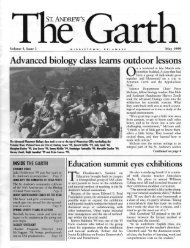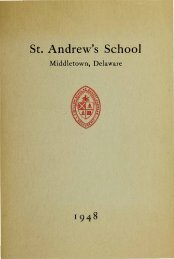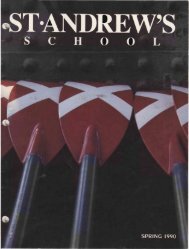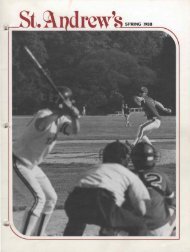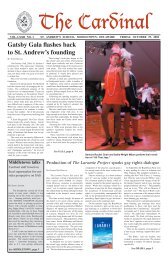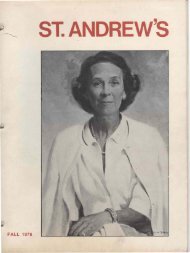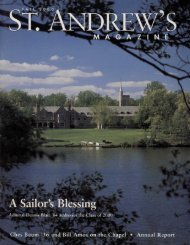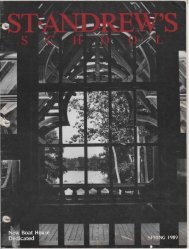Untitled - Saint Andrew's School Archive - St. Andrew's School
Untitled - Saint Andrew's School Archive - St. Andrew's School
Untitled - Saint Andrew's School Archive - St. Andrew's School
You also want an ePaper? Increase the reach of your titles
YUMPU automatically turns print PDFs into web optimized ePapers that Google loves.
THE CREATIVE ARTS<br />
At <strong>St</strong>. <strong>Andrew's</strong>, artistic<br />
endeavors spill over from<br />
the classroom into the<br />
everyday life of students.<br />
But the skills of expression are fostered<br />
in a classroom setting where<br />
students develop a firm understanding<br />
of the theoretical, historical and<br />
cultural background of the arts.<br />
<strong>St</strong>udent artists emerge and grow<br />
through formal training, free<br />
expression and close contact with<br />
established faculty artists, who, side<br />
by side with the students, are<br />
cultivating their own work. What<br />
emerges is a strong sense of the<br />
lifelong importance of the arts as<br />
something to be cherished, as an<br />
ongoing process of renewal and<br />
growth, as, ultimately, a goal of<br />
finding the inner expression of<br />
one's self.<br />
The visual arts are pursued in the<br />
art building, which is located on the<br />
north side of campus. With high<br />
ceiling, slanted roof, and interesting<br />
plays of light, students find the<br />
inspiration to create. The studio<br />
remains open throughout the day,<br />
and instructors are often available to<br />
assist students who wish to work in<br />
their free time.<br />
<strong>St</strong>. <strong>Andrew's</strong> is rarely without<br />
music. During the afternoons one<br />
can often hear the melodic strains of<br />
Chopin, the electronic pulse of a<br />
student rock band, or the harmony<br />
of voices in counterpoint with the<br />
crack of ball against bat, the swoosh<br />
of soccer ball in the net, or the cheer<br />
of enthusiastic spectators. But the<br />
first notes begin in the teaching<br />
studios and practice rooms, where<br />
students learn fundamentals of<br />
expression. Encouraged to perform<br />
for the <strong>School</strong> community, many<br />
students participate in recitals held<br />
in the acoustically live Cameron<br />
Room with its large Romanesque<br />
window. <strong>St</strong>udent bands are very<br />
common. Over the years some of<br />
our students have left our practice<br />
rooms and gone on to professional<br />
recording studios.<br />
The creative arts are respected at<br />
<strong>St</strong>. <strong>Andrew's</strong>, and involvement in<br />
the arts, regardless of talent or<br />
previous experience, is encouraged<br />
to provide a vital balance between<br />
academics and other cocurricular<br />
activities.<br />
The community sets aside one<br />
weekend each May, Arts Weekend,<br />
for the entire <strong>School</strong> to come<br />
together for recitals, concerts,<br />
exhibits and theater.<br />
History of Music<br />
D<br />
evelopment of music in Western<br />
Civilization from the Middle<br />
Ages to the present is traced by<br />
the group. The year's study is divided<br />
into three seminars (one each term) whose<br />
topics are selected from the following<br />
six: Middle Ages/Renaissance, Baroque,<br />
Classical, Romantic, Post-Romantic/Early<br />
20th Century, Contemporary/Modern.<br />
Among elements stressed is the evolution<br />
of forms and musical styles within<br />
the framework of cultural developments.<br />
Extensive listening experiences are integrated<br />
with the course material. (Elective<br />
minor fo r IV through VI Forms)<br />
Music Theory I<br />
S<br />
urveying the elements of the<br />
theory of music including notation,<br />
rhythm, tonality, harmonic<br />
progression, diatonic and altered harmony<br />
and basic forms is the intent of<br />
this course. (Elective minor for Ill through<br />
VI Forms)<br />
Music Theory II<br />
his course continues the study of<br />
the elements introduced in Music<br />
T<br />
Theory I, but in more depth and<br />
detail. Advanced part-writing and analysis<br />
of complex forms are explored.<br />
(Elective minor; Prereq uisite: Music Theory I)<br />
Music Composition<br />
M<br />
usic Composition examines<br />
the compositional styles and<br />
techniques from 1450 to the<br />
present from the viewpoint of melody,<br />
harmony, counterpoint and structure<br />
and the incorporation of these techniques<br />
into original compositions. Emphasis<br />
is on 20th Century style. (Elective<br />
minor for Ill through VI Forms; Prerequisites:<br />
Music Theory or examination by the<br />
Department)<br />
36




